Genital piercings
Below is a list of the available genital piercings at Bombshell Tattoo Galerie in Edmonton.
Genital Piercings are strictly available to persons over the age of 18, with valid govornment photo ID.
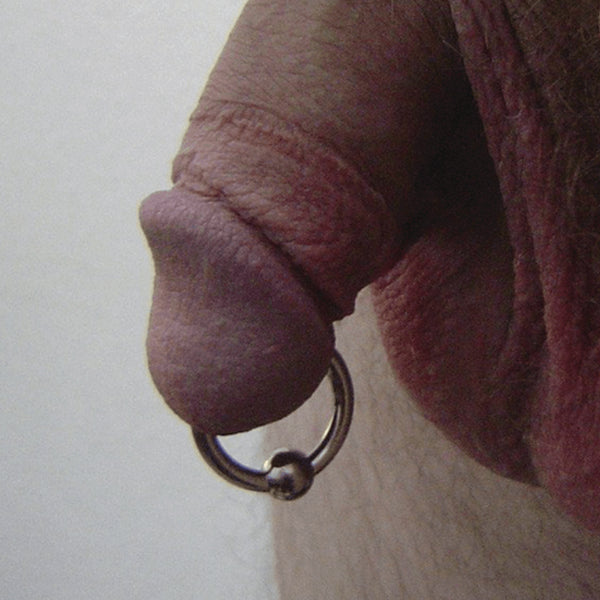
PRINCE ALBERT
This piercing goes in the end of the urethra and exits through a hole on the underside on the penis, ideally where the glans meets the shaft.
A PA piercing can be quite stimulating for not only yourself, but also those on the receiving end, as it adds both a little extra length and then the stimulation of the jewelry as well.
Healing time is 6 to 8 weeks
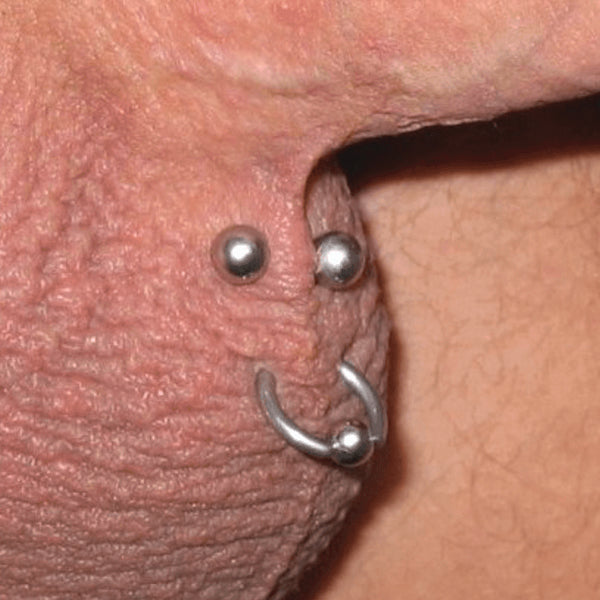
SCROTUM
A scrotum or Hafada piercing is a surface piercing that passes through the loose layers of tissue along the scrotum.
While anywhere along the scrotum can be pierced, this piercing is most commonly placed in the centre, along the scrotum “seam”
healing time is 2 to 3 months.
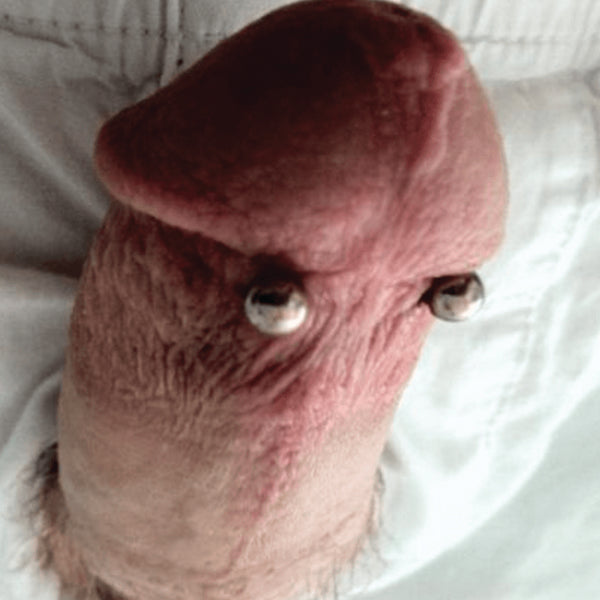
FRENUM
Traditional placement for this very popular piercing is through the loose skin on the underside of the penis, slightly back from the frenulum.
Many people get multiple frenum piercings, which can be referred to as a “Devil’s Ladder” or “Jacob’s Ladder.”
Frenum piercings are easy to sit through and healing tends to be relatively quick and is typically uncomplicated.
Healing time is 8 to 10 weeks.
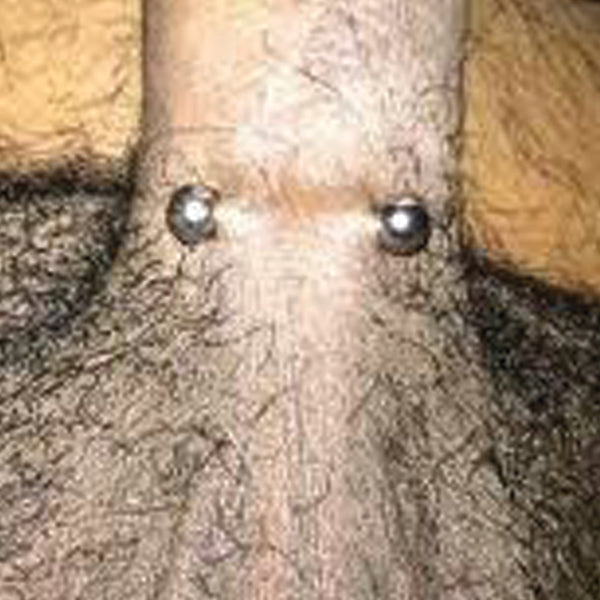
LORUM
The lorum piercing is located at the natural dividing line between the penis shaft and the scrotal sac.
Healing time is between 3 and 6 months.
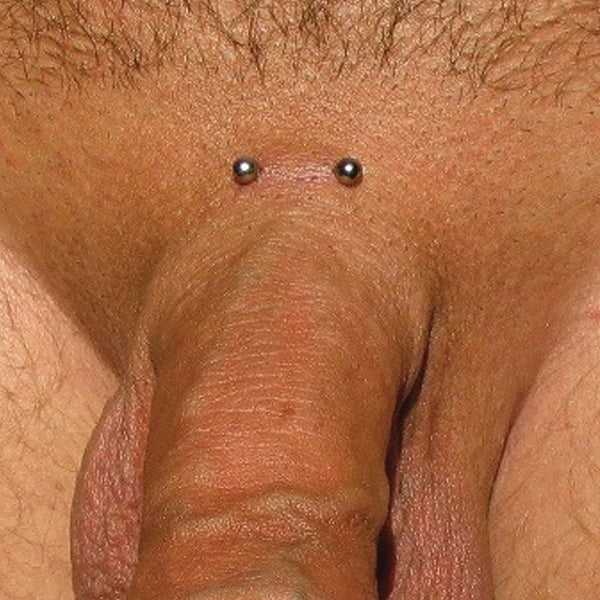
PUBIC
A pubic piercing is placed in the natural bend where the body connects to your shaft at the top of the penis.
We love this one because a ring in your pubic piercing can stimulate your partner’s clitoris when you are face to face during intercourse.
And thats just fun for everyone.
Healing time is 3 to 4 months
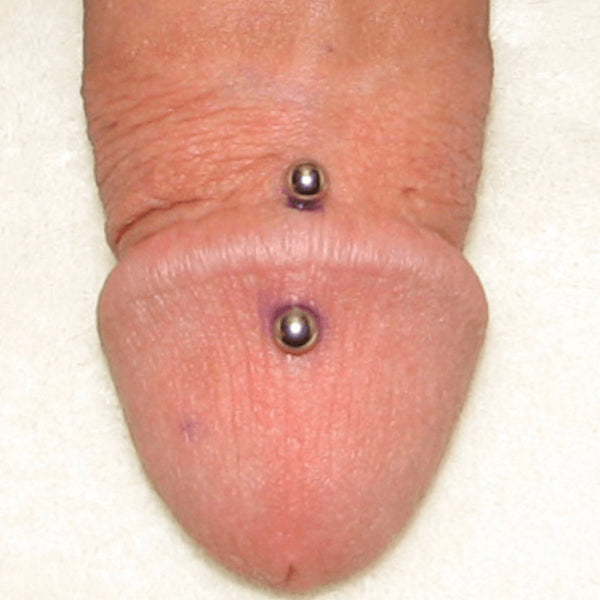
DYDOE
Dydoe is extremely anatomy-dependent, it is not suitable for an uncircumcised penis and the wearer must have a very flared glans to attempt it.
Even if the wearer is anatomically suited for this piercing and proper aftercare guidelines are followed, like all surface piercings there is a chance the piercing will migrate out during healing-or even afterward.
Healing time is 3 to 6 months
FAQ for penis piercings
What should I do before a genital piercing?
Aside from ensuring that you have had adequate sleep, are in good health and have eaten a meal recently?
TAKE A SHOWER.
You are getting up close and personal with our piercer during a genital piercing.
To make it as pleasant of an experience as something this invasive can possibly be, its best for both parties if there is not a hungover shame load of summer car seat swass thrown into the mix.
Should I shave before my appointment?
Shaving does make marking piercings a little easier for your piercer but is not strictly required.
If you feel that you have a bit of a monster fro going on down there and that our piercer may not be able to accurately place the piercing, a light trimming would be appreciated.
Does a penis have to be erect to be pierced?
No.
Our experienced piercer is able to correctly calculate the size of jewelry required to accommodate for erections and for any swelling during the initial healing.
Which ones hurt the most?
Like all body modification, choosing what you want and where based on temporary pain will likely result in disappointment.
Just get what you want pierced!
Which penis piercings feel the best for the wearer?
It really depends on what floats your boat!
While a Prince Albert will give you direct urethral stimulation, afrenum piercing gives attention to the sensitive underside of the shaft which is awesome too!
With penis piercings it really is a case of different strokes for different folks.
What penis piercing feels best for your partner?
Again this is a case of what you personally like, and what activities you prefer.
For oral sex we find the Prince Albert and frenum are fun.
For vaginal sex our experience is that the Prince Albert is great for G-spot stimulation.
The Prince Albert and reverse PA can all provide prostate stimulation during anal sex, but this also depends on the position.
We are sure there are many more ups and downs that we haven't heard of, so other than these few it's up to you to experiment!
Can I lose sensation from a penis piercing?
No.
You also won't go to hell, grow hair on the palms of your hands or go blind.
Nerves in the penis are plentiful (obviously) and traditional penis piercings do not intersect areas that can affect sensation or function.
Likewise these piercings do not penetrate any part of your genitals that are involved in sperm production, your little swimmers will continue their swimming.
Even scrotum piercings only penetrate superficial layers of skin, they do not penetrate the testes.
how soon after can I have sex?
While you do not have to abstain from sex during the entire healing process we do recommend youuse common senseand pay attention to your body.
If it hurts, stop.
Sometimes this means abstaining for several days after the initial piercing, but more often it means a week or more.
If you do have sex before the end of the healing period (listed on your aftercare form), make sure to use a condom and make sure your sex is fluid-safe—even for oral sex.
This is true even if you are long term monogamous with your partner as everyone has different bacteria natural to their body. This means you can pick up an infection from your partner during healing, even if you normally have unprotected sex.
Don't be a fool, wrap your freshly pierced tool.
If I get a penis piercing, will I have to sit to pee?
There is always that potential, yes.
The initial jewelry that allows extra space for swelling usually little more than an extra dribble—so you may want to sit or stand over the toilet instead of back from it.
Depending on how much you like whoever else you live with...Stretching to larger jewelry can redirect the stream a bit more.We find the bigger the jewelry, the more you'll have to practice, but practice makes perfect.
What to expect
Body piercings vary in healing times anywhere from 8 weeks to a several months depending on the
piercing site.
Everyone’s body is different so be patient and allow your body the time it needs to heal.
Initially there may be bleeding, or occasionally slight bruising around the piercing site.
Slight to moderate swelling can be expected.
The tissue around the piercing can become tender and slightly
red/pink during the first few weeks of healing.
A clear or light yellow discharge might occur off and
on indefinitely.
This discharge forms a crust which you can rinse off gently with warm water.
Do not touch or pick at your piercing and never rotate the jewelry while your piercing is healing!
What to do
Rinse your piercing twice daily (or as recommended by your piercer) in warm running water to soften and remove any crust that may have formed around your piercing.
Warm water helps keep
the area clean as well as increasing circulation which is beneficial to healing.
After the warm water rinse, follow with Simple Care Spray or a Sterile Wound Wash Saline available at any pharmacy.
Spray directly on the piercing twice daily and leave your piercing
alone. DO NOT make your own salt solution at home as this can impede healing.
We are not responsible for lost jewelry so please check your jewelry daily with freshly washed hands.
Threaded jewelry can loosen and fall off.
Playing with your jewelry not only increases your chances of complications during healing, but it may also result in the loosening of threaded ends and in turn the loss of the piercing site so keep your hands away from your piercing as much as possible.
Ensure anything that comes into contact with your piercing such as clothing, bedding, towels etc. are
clean until your piercing is fully healed.
What not to do
Do not touch your piercing unless you are checking the threading. Do not allow anyone else to
touch your piercing.
Never pick at or rotate your jewelry.
Do not use Q-Tips or cotton swabs or any other materials that may leave fibers behind.
Do not bandage your piercing. Refrain from wearing tight clothing.
Do not use antibacterial soaps, peroxide, rubbing alcohol, Bactine, antibiotic ointments
(Polysporin)or other first aid products unless instructed to by your doctor.
Do not submerge your piercing in any bodies of water including bathtubs, lakes, oceans, hot tubs
swimming pools, saunas etc. until it is fully healed.
Do not remove or change your jewelry for at least 8-12 weeks or as directed by your piercer.
Always check with your piercer as to suitable jewelry options for your particular piercing and
anatomy and always be aware of the quality of the jewelry you are putting in your body.
Do not share jewelry. This puts you at risk for disease and/ or infection transmission.
Do not rely on the advice of friends, family or the internet.
Your piercer knows what works best
for her practices. If your piercer is unavailable, or if you suspect complications or infection please
contact your doctor.
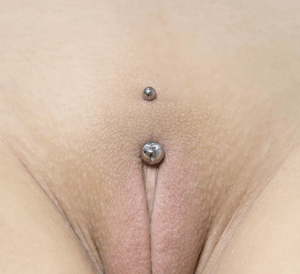
CHRISTINA
Located where the outer labia meet on the pubic mound. It is anatomy dependant, and often requires clients to have a “lip”or fold of skin in the region.
Our experienced piercer can check your anatomy and eligibility for this piercing location.
Healing time is 5 to 9 months.

VERTICAL HOOD
The vertical clitoral hood piercing is not only one of the most visually appealing piercings for female genitals, but also one of the most enjoyable.
The jewelry of the piercing goes through the hood vertically, sitting top-to-bottom with the ball of your jewelry resting on the clitoris.
Healing time is 6 to 8 weeks.

INNER LABIA
The inner labia piercing enters and exists though the thinner, hairless skin of the labia minora.
The thin, yet strong skin of the inner labia tends to have a much easier time healing than the outer labia.
Healing time is 6 to 8 weeks.
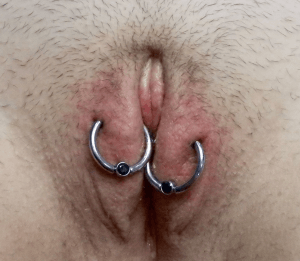
OUTER LABIA
The outer labia piercing is one that enters and exits the labia majora, or “outer lips” where the tissue is much thicker than the inner labia.
Due to the rubbing and irritation whilst healing, we find that if you have larger or closer thighs, you may also want to consider choosing another piercing, as healing may be especially difficult for you.
Healing time is 4 to 6 months.
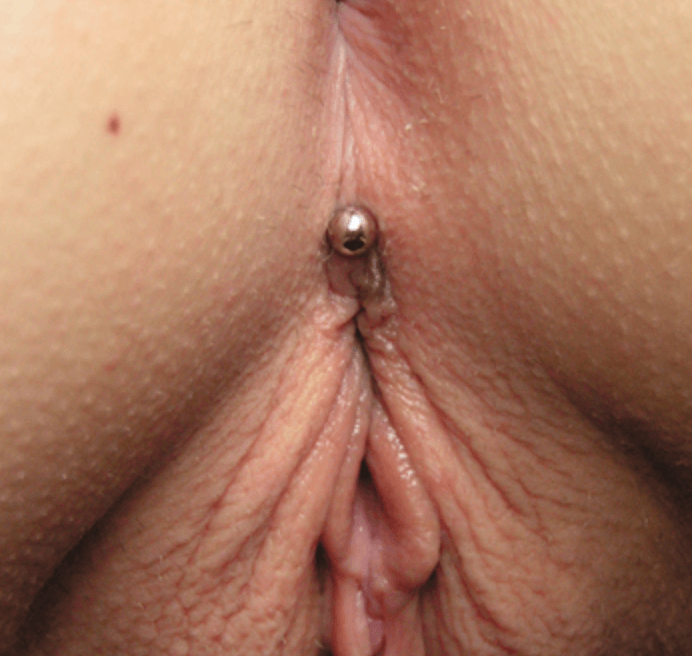
FOURCHETTE
The fourchette piercing is placed where the inner labia meet at the rear of the vaginal opening. This, like most female genital piercings is extremely anatomy dependent, in order to even consider this piercing you must have a pronounced “pinchable” lip of skin at the rear of the vaginal opening.
Healing time is 6 ot 8 weeks.
FAQ for Vagina piercings
What should I do to prepare?
Genital piercings hurt, let's not kid ourselves here. So please ensure you get a good night sleep, and definitely have something to eat prior to getting pierced.
Other than that, the most important thing we recommend is...
Take a shower!
Our piercer will be getting very up close and personal with your up close and personals, so to ensure its the least awkward experience possible please ensure you are keeping up with your personal hygiene prior to your appointment.
Do I need to shave first?
Shaving does make marking piercings a little easier for your piercer but is not strictly required.
If you feel that you have a bit of a monster fro going on down there and that our piercer may not be able to accurately place the piercing, a light trimming would be appreciated.
If you normally shave you can continue to do so—just ensure to keep shaving creams and hair clippings out of the piercing, especially during the initial healing.
Can I get pierced during "that time of the month"
You sure can, our professional piercer is neither squeamish nor afraid of shark week.Just be aware that you may bleed a little more than normal and/or be more prone to dizziness.
Especially if you are one of the many women who suffer from lowered iron during that timeframe.
Definitely make sure to eat a good meal beforehand, to keep your blood sugar steady, and avoid anything that thins your blood, like alcohol, aspirin, Tylenol, or caffeine.
Extra attention to personal hygiene is certainly appreciated by our staff if you intend on getting pierced during this time.
Can I lose sensation?
It depends on the piercing type but when these piercings are done by a skilled, qualified and experienced professional the risks are very minimal.
While you should always seek to get body modification only from qualified and skilled professionals, it is extremely important to not settle for second best on these piercing types.
Due to the proximity to nerve bundles on some of these piercings we highly recommend you do not trust just any bargain basement piercer with the future of your sex life.
Our professional piercer can help guide you as to which piercings will be best for your lifestyle.
Will urination affect my new piercing?
Other than a little sting, urine should not concern your piercing, if it does irritate you, we recommend washing the piercing with a saline solution after urination.
Urine, otherwise, is sterile and carries the same bacteria that is native to your own body, so should never be the cause of an infection.
We do, however, always recommend that you practice good hygiene during the healing process of your fresh genital piercing.
How much will it hurt?
The thought of getting your genitals pierced might not be everyones cup of tea, but they are actually not that bad. Most piercings such as a clitoral hood are through relatively thin skin, and can be some of the easiest piercings to get, and heal.
However, some of the piercings in this area such as the outer labia and Christina piercings, which travel through thicker skin and or more flesh, can be a bit more to sit through. Both of these also heal much more slowly due to the depth of the piercing.
Clitoris piercings can be... different... to sit through, but we find the end result is certainly worth the intensity.
At the end of the day, all piercings are going to hurt to varying degrees, so just get the one you want!
Which one will feel best?
For most women a vertical hood piercing is the choice that best balances aesthetics, ease of healing, and clitoral stimulation.
How long until I can have sex after my new piercing?
While you don't have to abstain entirely from sexual activities, going easy and taking a bit of time off certainly is advised.
The only activity we strictly recommend against is unprotected oral sex as it is the single fastest way to irritate your piercing and potentially cause infections.
Any sexual activity during the healing period should always be fluid-safe, so this means dental dams and condoms where applicable.
This is important even if you are long term monogamous as everyone's body has its own natural bacteria types and levels, so you can still contract an infection from your trusted partner during the healing process if protection is not worn.
The best advise we can give in terms of how long to take it easy during the healing process is that if it hurts, don't rush it.
If you are still experiencing irritation, stinging or pain at the piercing site for longer than you feel is normal, please don't hesitate to contact our piercer via the form below, or call the shop.
What to expect
Body piercings vary in healing times anywhere from 8 weeks to a several months depending on the
piercing site.
Everyone’s body is different so be patient and allow your body the time it needs to heal.
Initially there may be bleeding, or occasionally slight bruising around the piercing site.
Slight to moderate swelling can be expected.
The tissue around the piercing can become tender and slightly
red/pink during the first few weeks of healing.
A clear or light yellow discharge might occur off and on indefinitely. This discharge forms a crust which you can rinse off gently with warm water.
Do not touch or pick at your piercing and never rotate the jewellery while your piercing is healing!
What to do
Rinse your piercing twice daily (or as recommended by your piercer) in warm running water to soften and remove any crust that may have formed around your piercing.
Warm water helps keep the area clean as well as increasing circulation which is beneficial to healing.
After the warm water rinse, follow with Simple Care Spray or a Sterile Wound Wash Saline available at any pharmacy.
Spray directly on the piercing twice daily and leave your piercing
alone.
DO NOT make your own salt solution at home as this can impede healing.
We are not responsible for lost jewellery so please check your jewellery daily with freshly washed hands.
Threaded jewellery can loosen and fall off.
Playing with your jewellery not only increases your chances of complications during healing, but it may also result in the loosening of threaded ends and in turn
the loss of the piercing site so keep your hands away from your piercing as much as possible.
Ensure anything that comes into contact with your piercing such as clothing, bedding, towels etc. are
clean until your piercing is fully healed.
What not to do
Do not touch your piercing unless you are checking the threading. Do not allow anyone else to touch your piercing.
Never pick at or rotate your jewellery.
Do not use Q-Tips or cotton swabs or any other materials that may leave fibres behind.
Do not bandage your piercing. Refrain from wearing tight clothing.
Do not use antibacterial soaps, peroxide, rubbing alcohol, Bactine, antibiotic ointments (Polysporin)or other first aid products unless instructed to by your doctor.
Do not submerge your piercing in any bodies of water including bathtubs, lakes, oceans, hot tubs swimming pools, saunas etc. until it is fully healed.
Do not remove or change your jewellery for at least 8-12 weeks or as directed by your piercer.
Always check with your piercer as to suitable jewellery options for your particular piercing and anatomy and always be aware of the quality of the jewellery you are putting in your body.
Do not share jewellery. This puts you at risk for disease and/ or infection transmission.
Do not rely on the advice of friends, family or the internet. Your piercer knows what works best for their practices.
If your piercer is unavailable, or if you suspect complications or infection please contact your doctor.


